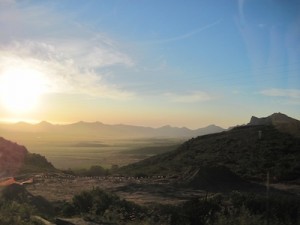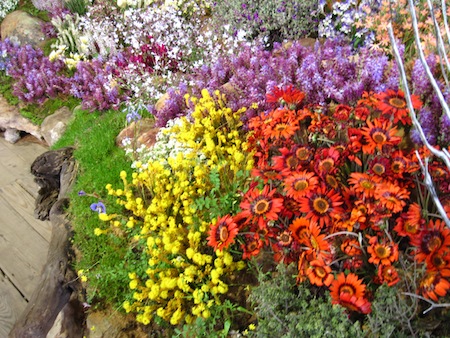Planning a visit to the West Coast and Namaqualand Spring wildlowers? We just got back. It was amazing. The South African Spring Wildflower Route is probably unsurpassed in depth and breadth anywhere on earth.
Where are the wildflowers?
When are the wildflowers?
Consensus is mid-Aug to Mid-Sep, with the peak during the last week of August. This is very early Spring and the weather is variable. The flowers only open around 11 am when the temperature is over about 17° C and the sun is shining. And they face north, so driving south you see them best.
How do I get there?
Take the R27 from Capetown to Langebaan (120km), or the N7 north to Clanwilliam (around 200 km further on) and on to Springbok (a further 330km).
The R364 gravel back road between Clanwilliam and Nieuwoudtville was highly recommended. So we printed the story and headed south to Cape Town using some expiring Voyager miles on SAA.
Our pilgrimage
The whole idea came from an old memory sustained by a photo in a dusty album. One heavenly day in 1971 we found ourselves in Stompneuspunt surrounded by carpets of daisies. A decade or two later dazzling displays tantalized us out of a train window on a ride from Cape Town to Johannesburg. We Tried West Australia one September. It was not anything to write home about.
Googling “West Coast Spring Flowers” yielded a link Cape Town family holiday Magic.com which gave some very specific suggestions about the best way to do the Flower Route. It said head north as fast as you can and then work your way south.

Bypassing Malmesbury and Moorreesburg, we arrived in Clanwilliam just after sunset. By the time we arrived at the Karu Kareb Wilderness resort it was dark. Vicki took one look at the expensive luxury tent in the headlights and we turned tail and headed back to the relative civilisation of the lodge house.
Later that afternoon we drove our little hired Fiat Gande Punto back through the remarkable rock formations of the Pakhuis Pass built by Thomas Bain in 1874-7 through the Cedarburg to Clanwilliam.
So last year, speaking to my Cape Town brother in September, too late for the 2010 display, I resolved that this year would be the year of the flowers.
So we flew to Cape Town, and hired a car from SixT. By three o’clock that Monday afternoon 29 August 2011 we were trapped in dreadful traffic invisible to our GPS. It eased up around 4:00 and we were merrily on our way up the N7 north to Clanwilliam.
Next morning we consulted with the charming owner/concierge who pointed us up the R364 to the Biedouw Valley turnoff. We took the turnoff and shortly later found ourselves overlooking the most heavenly valley with the paradisiacal display of the wildflowers I’d been dreaming about for so many years. We just made it, because the weather was turning and a brisk north westerly wind was summoning ragged cloud to obscure the sun so crucial to flower spotting.
There were fields of bright orange, yellow, white, pink and purple flowers of all sizes. You name it: Olifantsvoet and hotnotskooigoed, sparaxis, gladioli, wahlenbergia, arctotis… To me it was just daisies of every imaginable colour. You really need to have a picnic lunch and just find a field and sit. And maybe meditate. So beautiful. And you can buy spiffing local specialties like Rooibos and Honeybush blend at the farmstalls.
Clanwilliam Flower Show
Clanwilliam is one of the 10 oldest towns in South Africa, lying at the foot of the majestic Cedarburg. Did you know the town was initially known as Jan Disselsvalleij? It was renamed Clanwilliam in 1814.
An enthusiastic team starts about three or four weeks before the opening of the show. About four days before the opening day, long life wildflowers are picked and planted, and the frailer plants are placed in position in the last two days. One or two examples of each of the specimens are placed in water and buried in sand and camouflaged with moss and sods in an amazing set of huge boulders that must have needed twenty strong men to place.
During the last week of August every year the old Dutch Reformed Church becomes a floral showcase for the Her Majesty Mother Nature’s wildflowers. Visitors pour into learn about our amazing natural heritage.
The region hosts tremendous differences in topography (Cedarburg, Karroo, Sandveldt, Wetlands and Coastal areas). So the area is blessed with an exceptional variety of wild flowers. The greater part of the district falls within the world-renowned Fynbos Biome. Many species in the district are found nowhere else in the world. About 400 species from 52 families are exhibited at each show. Here is a picture that doesn’t even begin to suggest the majesty of the display.
You will want to spend a couple of nights in the area to give you time also to check out the Ramskop Nature Reserve and Wild Flower Garden, and maybe have a picnic by the Clanwilliam Dam. Next day we headed across to Lamberts Bay and thereafter down the N7 back to Cape Town.
Really well worth the pilgrimage.
Our next trip is going to take us back up the R7 for about an hour to the West Coast National Park and a visit to some special places near Postburg. Our imagination was tickled by the Giraffe we saw out of the car window on the left-hand side of the road as we faced table Mountain rearing up in the distance on that Wednesday afternoon.
And if you’d like to learn to meditate while you are in Cape Town – just leave a contact note and we’ll connect you…

